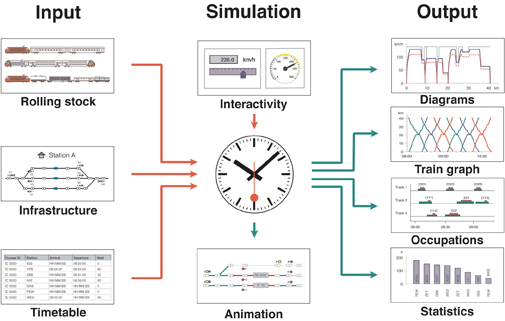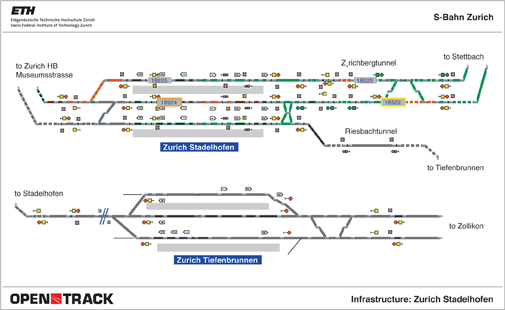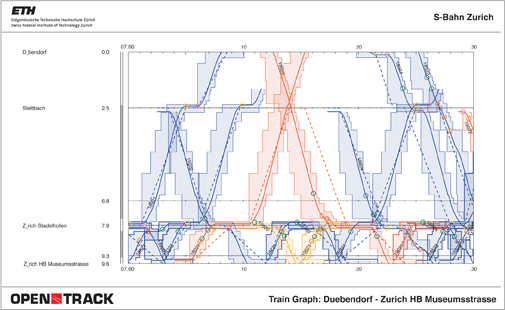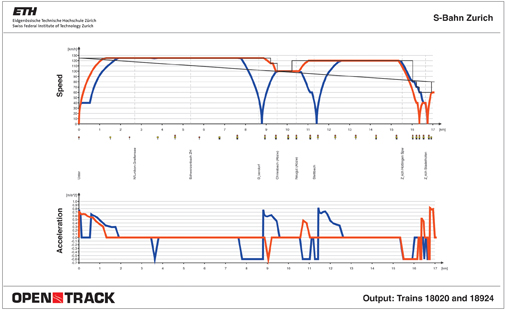Railroad simulation using OpenTrack
Posted: 6 June 2007 | | No comments yet
OpenTrack is a user-friendly railroad network simulation program. It is a microscopic model that simulates rail system operations based on user defined train, infrastructure and timetable databases. OpenTrack can be used to evaluate and test infrastructure plans and operating schedules in order to optimise network and timetable design. It can be run on several different computer platforms and incorporates the benefits of object oriented programming language with a common data interface structure. The program has been used successfully on projects in Europe, Asia, Australia and America.
OpenTrack is a user-friendly railroad network simulation program. It is a microscopic model that simulates rail system operations based on user defined train, infrastructure and timetable databases. OpenTrack can be used to evaluate and test infrastructure plans and operating schedules in order to optimise network and timetable design. It can be run on several different computer platforms and incorporates the benefits of object oriented programming language with a common data interface structure. The program has been used successfully on projects in Europe, Asia, Australia and America.
OpenTrack is a user-friendly railroad network simulation program. It is a microscopic model that simulates rail system operations based on user defined train, infrastructure and timetable databases. OpenTrack can be used to evaluate and test infrastructure plans and operating schedules in order to optimise network and timetable design. It can be run on several different computer platforms and incorporates the benefits of object oriented programming language with a common data interface structure. The program has been used successfully on projects in Europe, Asia, Australia and America.
Railways are highly inter-related systems combining fixed infrastructure networks with specific rolling stock and a precisely choreographed timetable. Careful planning is critical for railway success since network capacity cannot be easily calculated, infrastructure is very expensive, changes are very disruptive to operations and poorly planned infrastructure can significantly increase operating costs. Furthermore, planning highly inter-related systems is particularly challenging because many different combinations of infrastructure improvements, rolling stock and timetable changes can be used to achieve any given objective.
Under these conditions it is clear that railway simulation is essential in all aspects of railway planning from initial feasibility studies to detailed operational/schedule planning. A key benefit of railway simulation is the ability to fully evaluate many different alternatives and identify an optimal plan, a task that is essentially impossible to perform by hand except for very simple cases.
A railway simulation program is essentially a set of mathematical assumptions that attempt to duplicate actual train operations. Simulation programs allow users to evaluate the impacts of user-defined changes on the rail system operation. Railway simulation programs can be used to estimate the stability of new timetables, determine the minimum infrastructure requirements for a given timetable, or evaluate the impact of rolling stock changes.
A significant benefit of simulation programs is their ability to evaluate the impact of incidents or time-based network changes (e.g. maintenance) on railroad operations. In summary, effective railroad simulation programs enable planners to better understand the inter-relationships between infrastructure, rolling stock and schedules, ultimately leading to more creative and efficient problem solving.
OpenTrack Railway Simulation Program
OpenTrack is a railway simulation program developed at the Swiss Federal Institute of Technology’s Institute for Transport Planning and Systems (ETH IVT). OpenTrack was developed for use on personal computers (multiple operating systems) using the latest information technology and based on the most precise modeling approach, namely a microscopic synchronous simulation model.
As a microscopic model, OpenTrack simulates the behaviour of all railway elements (infrastructure, rolling stock and timetable) as well as all the processes between them. In contrast, macroscopic models (the other type of simulation model) use average or statistical data to evaluate transport system operation rather than calculated individual unit (e.g. train) operational data. Therefore, microscopic simulation models provide a much more detailed assessment of network operations since they attempt to replicate actual railway operations over time by considering the activity of each individual train during a time step (e.g. every second) and then repeating the process for the entire simulation period. This also allows microscopic models to consider the impact of trains on each other in the simulation.
In summary, OpenTrack combines a detailed simulation modeling process with the latest in information technology to create a user-friendly efficient railway simulation tool.
Using OpenTrack
Figure 1 illustrates the three main elements of OpenTrack: data input, simulation, and output.
Data Input
OpenTrack administers input data in three modules: rolling stock (trains), infrastructure and timetable. Users enter information into these modules and OpenTrack stores it in a database. Once data has been entered, it can be used in any simulation performed with OpenTrack. For example, different segments of the infrastructure network can be entered separately into the database and then used individually to model operations on the particular segment or together to model larger networks.
Train data (locomotive and wagons) is entered into the OpenTrack database with easy to use forms displayed using pull down menus. Infrastructure data (e.g. track layout, signal type/location) is entered with a user-friendly graphical interface; quantitative infrastructure data (e.g. elevation) is added using input forms linked to the graphical elements.
Timetable data is also entered into the OpenTrack database using forms. These forms include shortcuts that enable data to be input efficiently. For example, users can designate hourly trains that follow the same stopping pattern an hour later. Since OpenTrack uses the RailML structure for timetable data, timetable data can also be entered directly from various different program output files as well as database files (more information on RailML is available at: www.railml.org).
One advantage of OpenTrack is that it enables users to adjust many variables that impact railroad operations. For example, users can simulate the impact of weather on traction by specifying the adhesion scenario. While OpenTrack provides standard default values for all variables, having the ability to adjust variables makes the program quite flexible.
OpenTrack Simulation Process
In order to run a simulation using OpenTrack the user specifies the trains, infrastructure and timetable to be modeled along with a series of simulation parameters (e.g. animation formats). During the simulation, OpenTrack attempts to meet the user-defined timetable on the specified infrastructure network based on the given train characteristics. OpenTrack uses a mixed continuous/discrete simulation process that allows a time driven running of all the continuous and discrete processes (of both the vehicles and the safety systems) under the conditions of the integrated dispatching rules.
The continuous simulation is dynamic calculation of train movements based on Newton’s motion formulas. For each time step, the maximum force between the locomotive’s wheels and the tracks is calculated and then used to calculate acceleration. Next, the acceleration function is integrated to provide the train’s speed function and is integrated a second time to provide the train’s position function.
The discrete simulation process models operation of the safety systems; in other words, train movements are governed by the track network’s signals. Therefore, parameters including occupied track sections, signal switching times, and restrictive signal states all influence the train performance. OpenTrack supports traditional multi-aspect signaling systems as well as new train control systems (e.g. European Train Control System – ETCS signaling) or moving-block systems.
Dynamic Rail Simulation
OpenTrack is a dynamic rail simulation program. As such, the simulated operation of trains depends on the state of the system at each step in the process as well as the original user-defined objective data (e.g. desired schedule).
A simple way of describing dynamic rail simulation is that the program decides what routes the trains use while the program is running. For example, when building the network, users identify various different routes that trains can use between two points; OpenTrack decides, during the simulation, which route the train will use by assigning the train the highest priority route available. If the first priority is not available, OpenTrack will assign the train the second highest priority route and so on.
OpenTrack’s dynamic nature allows users to assign certain attributes to specified times in the simulation. Thus, users can assign a delay to a particular train at a given station and time, rather than being limited to assigning a delay at the start and using it through the entire simulation. Similarly, users can define other types of incidents (e.g. infrastructure failures, rolling stock breakdowns) for particular times and places.
Finally, dynamic simulation enables users to run OpenTrack in a step-by-step process and monitor results at each step. Users can also specify exactly what results are displayed on the screen. Running OpenTrack in a step-by-step mode with real time data presented on screen helps users to identify problems and develop alternative solutions.
OpenTrack Output
One of the major benefits of OpenTrack is the great variety of data types, presentation formats, and specifications available to the user. During the simulation, each train feeds a virtual tachograph (output database) which stores data such as acceleration, speed, and distance covered. Storing the data in this way allows users to perform various different evaluations after the simulation has been completed.
OpenTrack allows users to present output data in many different formats including various forms of graphs (e.g. time-space diagrams), tables and images. Similarly, users can choose to model the entire network or selected parts, depending on their needs. Output can be used either to document a particular simulation scenario or as an interim product designed to help users identify input modifications for another model run. Figure 3 presents a graphical timetable (train graph) and Figure 4 presents a speed-distance diagram and acceleration diagram. These are only three examples of the many types of output that can be generated using OpenTrack.
OpenTrack Applications
OpenTrack has been used successfully on projects from a gondola railway in Andorra to developing a timetable for the Shanghai Transrapid. It has been used to model entire railway networks, streetcar systems, rapid transit lines, freight corridors, high speed rail systems as well as industrial railways.
Railway simulation – i.e. the ability to use a virtual railway laboratory to test new ideas and concepts – is extremely useful and has many possible applications. OpenTrack can replicate on the computer nearly any infrastructure, vehicle or operational strategy that can be implemented physically, and can do it extremely efficiently.
OpenTrack is frequently used to optimise future infrastructure investments. For example, to determine the most efficient location for passing tracks or to investigate the operational advantages of a more efficient signal system. These cases often involve very large financial investments and a small amount of rail network simulation can lead to considerable savings.
Another OpenTrack planning application is determining the capacity of rail segments or interchange points and helping to plan the most efficient means for increasing capacity or eliminating bottlenecks. OpenTrack can also be used to help determine the stability of service (schedule reliability) and/or the feasibility of a certain timetable; these types of projects often focus on vehicle characteristics and operating strategies. Several specific projects are described below.
Switzerland Bern East Network
The Swiss National Railway used OpenTrack to analyze the impact of the new Lötschberg Alpine Basis Tunnel on operations on the rail network east of Bern. Here international freight trains, national long-distance trains and Bern’s comprehensive regional rail network are concentrated on a constrained infrastructure network. OpenTrack was used to identify and prioritize needed infrastructure investments, to evaluate the timetable stability and to analyze different operating concepts.
HSL Zuid
Infraspeed, a Siemens daughter firm responsible for developing the new HSL Zuid Dutch high speed rail line, has used OpenTrack to evaluate and illustrate the safety engineering and operational impacts of ETCS Level 2, the impacts of shifting to ETCS Level 1 and to examine the impacts of disturbances on operations. OpenTrack will continue to be used during HSL Zuid commercial operations as part of the system for assessing the contractual bonuses/penalties; in particular it will be used to help determine who is responsible for problems and to what degree they are responsible.
Railway Electrical Power Demand
OpenTrack has also been successfully integrated into larger IT-systems or coupled with other applications. For example, the ETH Zurich and Institute for Railway Technology GmbH (Dresden) have developed a module that allows OpenTrack to compute the power demand on the electrical network. This was accomplished by creating an interface that models the contact of the pantograph with the contact wire. OpenTrack calculates the electrical demand each second and this is then transferred to demand on the electrical network also in one second intervals. This provides a very realistic and precise picture of the railway network’s demand on the electrical network.
Customer Information System Development and Testing
Another example of extending OpenTrack’s capabilities was using it to help test the Swiss National Railways’ new passenger information system (called CUS) developed by the company Softlab. Each stage of the new passenger information system needed to be carefully tested before it could be placed in service. OpenTrack was extended so that it could be used to generate information in a format compatible with the CUS; this allowed the CUS developers to test how the customer information system would react to various different disturbances (e.g. train delays) without relying on field trials. This reduced the time and expense needed to implement this important new system.
Conclusions
OpenTrack is an efficient and effective railroad simulation program. It has been used successfully in many different railway planning projects throughout the world. The program’s use of object oriented programming and the RailML data structure makes it particularly effective since the program can be modified relatively easily to address specific applications and since data can be transferred easily to and from other programs based on RailML.


Figure 1: The three main elements of OpenTrack: data input, simulation and output


Figure 2: A screen shot illustrating the OpenTrack automation. It shows trains operating on the network


Figure 3: A graphical timetable (train graph)


Figure 4: Speed-distance and acceleration diagram
References
- www.opentrack.ch
- Nash, A. and D. Huerlimann (2004) Railroad simulation using OpenTrack. In: Allan, J., R.J. Hill, C.A. Brebbia, G. Sciutto, S. Sone (eds.). Computers in Railways IX, WIT Press, Southampton, 2004, pp. 45-54.
- Nash, Andrew; Railway Simulation with Open Track – Presentation at 1st International Conference on Computer Modeling for Operations sponsored by Railway Age-SYSTRA Consulting; Delray Beach, Florida; February, 2004; www.andynash.com/abn_web_pubs/opentrack2004pres.pdf.
About the authors
Andrew Nash is a researcher at the ETH Zurich’s Institute for Transport Planning and Systems (IVT). His focus is on public transport efficiency, rail network planning and simulation, communications, and transport policy. Nash serves on the Transportation Research Board’s Intercity Passenger Rail Transport Committee and can be reached at: [email protected].
Daniel Huerlimann is CEO of OpenTrack Railway Technology Ltd. He received his Doctorate from the ETH’s Department of Civil, Environmental and Geomatic Engineering in 2001. He was a researcher and teaching assistant at the IVT for over ten years and previously was a software developer. He can be reached at: [email protected].
Stay Connected with Global Railway Review — Subscribe for Free!
Get exclusive access to the latest rail industry insights from Global Railway Review — all tailored to your interests.
✅ Expert-Led Webinars – Gain insights from global industry leaders
✅ Weekly News & Reports – Rail project updates, thought leadership, and exclusive interviews
✅ Partner Innovations – Discover cutting-edge rail technologies
✅ Print/Digital Magazine – Enjoy two in-depth issues per year, packed with expert content
Choose the updates that matter most to you. Sign up now to stay informed, inspired, and connected — all for free!
Thank you for being part of our community. Let’s keep shaping the future of rail together!







